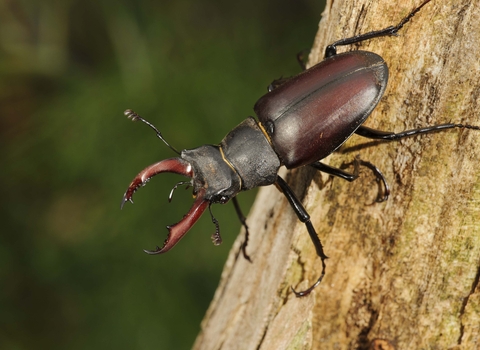
Stag Beetle ©Terry Whittaker/2020VISION
Stag beetle
Famous for its fearsome jaws, the stag beetle does not have the bite to match. Look for it in woods, parks and gardens in South East England in summer. Males display their massive jaws to attract females and duel with their rivals.
Scientific name
Lucanus cervusWhen to see
May to AugustSpecies information
Category
Statistics
Length: 5.0-7.5cmProtected in the UK under the Wildlife and Countryside Act, 1981. Priority Species under the UK Post-2010 Biodiversity Framework.
Habitats
About
The stag beetle is the UK's largest beetle and is found in South East England, particularly in South and West London. It prefers oak woodlands, but can be found in gardens, hedgerows and parks. The larvae depend on old trees and rotting wood to live in and feed on, and can take up to six years to develop before they pupate and turn into adults. The adults have a much shorter lifespan: they emerge in May with the sole purpose of mating, and die in August once the eggs have been laid in a suitable piece of decaying wood. Look for the adults on balmy summer evenings, when the males fly in search of mates. Once the male has found a mate, he displays his famously massive, antler-like jaws to her, and uses them to fight off rival males, in a similar fashion to deer.How to identify
With their massive antler-like jaws and reddish-brown bodies, male stag beetle are unmistakable. Females look similar to Lesser stag beetles, but are larger, with smaller heads and brown wing cases instead of black ones.Distribution
Found in South East England.In our area
Suffolk Wildlife Trust are encouraging people to create stag beetle habitat on their land, and also record stag beetle sightings:
Did you know?
The jaws of the male stag beetle look fearsome, but are actually quite weak, making this beetle pretty harmless to humans. In fact, it is possible that their jaws are so large that they prevent them from feeding. However, it is still unclear whether either sex actually feeds during their short adult life; if they do, it is likely that they eat tree sap.Suffolk Wildlife Trust are encouraging people to create stag beetle habitat on their land, and also record stag beetle sightings:
